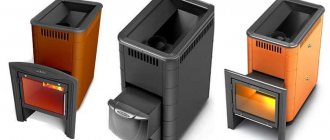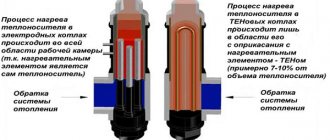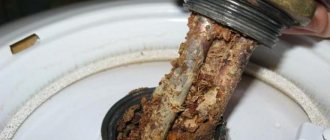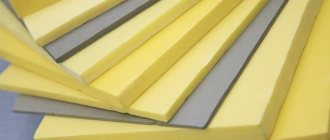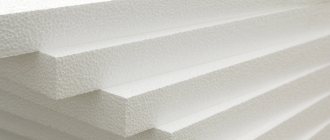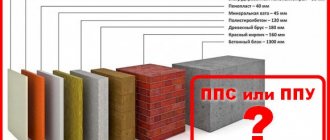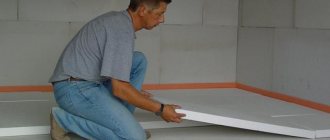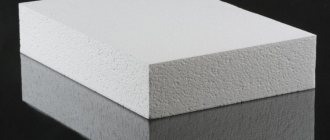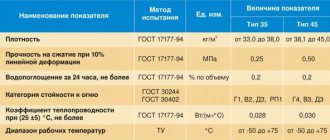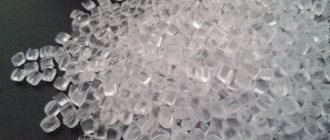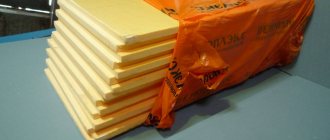Types of PPE insulation materials
At the moment, a huge range of products is produced, which can be called thermal insulation made of foamed polyethylene.
One of the differences between such products, which may not be visible from the outside, but is significant in operation, is the type of polyethylene foam from which they are made. This can be a “cross-linked” or “non-cross-linked” polymer, the first of which has higher physical and chemical properties (strength, operating temperature range, etc.). However, when choosing an insulating product for a particular purpose, the design of the product usually plays a large role.
Resistance of polystyrene foam to chemical influences
The problem of mold and efflorescence on the surface of building structures is discussed very often today. If foam plastic is used as insulation during construction, then the problem can be easily dealt with and this is due to their high resistance to aggressive mineral environments such as lime, gypsum, cement, clay, etc.
Resistance of polystyrene foam to chemicals.
| EXPOSURE SUBSTANCE | |
| Salt solutions (sea water) | + |
| Soaps and wetting solutions | + |
| Bleaching agents, for example: hypochlorite, chlorine water, hydrogen peroxide solutions | + |
| Diluted acids | + |
| Hydrochloric acid 35%, nitric acid up to 50% | + |
| Anhydrous oxygen, for example: fuming sulfuric acid, 100% formic acid | — |
| Caustic sodium, ammonia | + |
| Organic solvents. For example: acetone, ethyl acetate, benzene, xylene, lacquer thinner, trichlorethylene | — |
| Saturated aliphatic hydrocarbons, medical gasoline, white spirit | — |
| Paraffin oils, Vaseline | +- |
| Diesel fuel | — |
| Carburetor fuel (normal gasoline and super gasoline) | — |
| Alcohols, for example: methanol, ethanol | +- |
| Organosilicon oil | + |
| + stable: polystyrene foam does not collapse even after prolonged exposure | |
| + - conditionally stable: with prolonged exposure, polystyrene foam can shrink or the surface layer is destroyed - | |
| - unstable: polystyrene foam shrinks or dissolves more or less quickly | |
The listed properties are basic, but not the only ones.
Characteristics, properties and scope of application
To determine the harm of polystyrene foam as insulation, it is necessary to consider its properties, composition and manufacturing method
Special attention should be paid to the area of application, since it is the decisive factor in identifying the impact on humans.
Structure of the material on a cut
Insulation
Foam plastic is almost irreplaceable as a material for protection against cold.
- Its porous structure can significantly reduce thermal conductivity.
- The polystyrene foam holds its shape perfectly, something that not one of the insulation materials in this price category can boast of.
- It is more than 90% air, so it does not burn and does not support this process.
- In its production, a minimum amount of styrene-containing substances is used, which is considered a decisive factor in determining environmental cleanliness.
- The maximum service life of foam plastic exceeds 50 years. This is evidenced by the installation instructions and the quality certificate included with most products made from this material.
Use as external insulation of houses, amateur photo
Release of toxic substances
It is believed that polystyrene foam, when burned or subjected to strong heating, releases styrene, which is very harmful to the body and in its pure form can become a real poison. However, the harmfulness of basalt insulation is sometimes much higher, especially if violations were made during its manufacturing process, which leads to the decision to use a less dangerous material, although it emits unnecessary substances.
The use of this material was approved back in the Soviet Union, taking into account the relevant GOST
Thus, it becomes clear that it is quite safe to insulate a loggia or other premises using polystyrene foam. In the same cases where it will emit harmful substances, there are many other materials, in the form of vinyl wallpaper and plastic interior items, that can cause more harm.
Rodents really like this material. What may indicate lack of toxicity
Application area
When determining the degree of harmfulness of a given material, it is necessary to consider the places where it is used.
First of all, it is worth understanding that polystyrene foam is used indoors only when insulating plastic windows or entrance doors. In all other cases, cheaper materials are used. Therefore, its impact on humans is minimal. Separately, it is worth noting the insulation of walls in contact with the street. The fact is that it must be done only from the outside (see also the article Insulating facades with foam plastic: we do external thermal insulation with minimal time and money)
Otherwise, condensation will appear between the insulation and the wall, mold and mildew will form. When plasterboard partitions are erected, it does not matter at all whether the basalt insulation is harmful or whether styrene foam releases. In this case, both of these materials are placed in such conditions that their use is not only the most optimal solution, but also environmentally friendly. The only unsafe place to use this insulation is considered to be a metal roof
However, taking into account the fact that foam plastic is separated from the immediate area of incandescence by a layer of waterproofing, and from the living space by a vapor barrier film, then using it for these purposes is quite acceptable.
Houses in Japan made entirely of foam plastic
Research and practice
Many novice craftsmen, doing installation work with their own hands, turn to specialists or the Internet for advice. However, there is no clear opinion from experts or reliable research from specialists on the issue of the dangers of this material.
Response from the Ministry of Emergency Situations to a request about the dangers of this material and its fire safety during the construction of residential buildings
At the same time, practice has shown that the location of the insulation and external influences on it cannot completely eliminate the release of harmful substances. True, the probability of such cases is so small and requires certain conditions that it is not worth taking it seriously.
It is also necessary to remember that the price of other environmentally friendly insulation materials is very high, and their natural components also emit harmful substances when burned or overheated.
Thickness of different types of material to achieve the same thermal insulation effect
Scope of application
Expanded polystyrene is used as an element for insulating various objects. This could be, for example, water pipes.
It is used to work with:
- window and door slopes;
- roofing;
- floor;
- walls.
High-density polystyrene foam is required where high demands are placed on the quality of structures. The use for pipe insulation is economically justified. They take block polystyrene foam so that in case of damage the pipe can be easily accessed. To do this, remove a certain area of the protective coating.
Expanded polystyrene is actively used for pipe insulation
Expanded polystyrene is actively used in the construction of transport routes. It is used because it reduces the vertical load on the road surface during the construction of structures. It is also used in the production of SIP panels. We can say that its scope of use is almost unlimited. It has a low density and is therefore not sufficiently resistant to mechanical damage. This must be taken into account when choosing it as a material for work.
Classification of expanded polystyrene
Regular foam
Thermal insulation material obtained by foaming polystyrene.
As mentioned above, its volume is 98% air, which is sealed into granules. This speaks not only of its excellent thermal insulation qualities, but also of its sound insulation properties. The main advantage of the material is the lack of ability to absorb moisture. In addition, it does not rot or biodegrade. Durable material, light weight and easy to use. It can be glued to any building material.
Expanded polystyrene is easy to burn, but it contains a substance called a fire retardant. This is what gives the foam the ability to self-extinguish. In addition, expanded polystyrene cannot be used to insulate facades. This is due to its low vapor permeability. And in order to carry out work with foam plastic under the roof, you should carefully consider the ventilation system.
Use depending on the brand of material
- PSB-S 15. The marking of polystyrene foam indicates that it can be used to insulate structures that are not subject to mechanical stress. For example, insulation of the roof, the space between the slings and the ceiling.
- PSB-S 25 and 25F. Common markings for polystyrene foam. It says that any surface can be insulated. Walls, facades, ceilings or flooring, roofing.
- PSB-S 35 and 50. This material can be used to insulate objects that are under constant high load.
Extruded polystyrene foam
Thermal insulation material, which has high effect and quality.
It is most often used to insulate building envelopes. And the thermal conductivity coefficient ranges from 0.027 to 0.033 W/m K. The structure of the material is cellular. And the complete closure of each cell provides absolute protection against water penetration. Therefore, this material is recommended for use where humidity is high or where the material can come into contact with water. This is insulation of the basement or foundation of a cottage. Even in conditions of insufficient waterproofing, extruded polystyrene foam will retain its thermal insulation qualities.
In addition, this material is highly resistant to various deformations. This feature allows it to be used as insulation for surfaces bearing heavy loads. For example, facades can be insulated with extruded polystyrene foam. Especially if the cladding material is very heavy.
As for the temperature. Expanded polystyrene is able to withstand sudden changes, from -120 to +175 degrees. At the same time, its structure remains intact and unharmed.
The disadvantages of this material are flammability, but, like polystyrene foam, its constituent elements can cause it to extinguish. Contact of polystyrene foam with complex carbohydrates can lead to destruction.
Properties
The product has a number of physical, chemical and biological properties. If we talk about mechanical features, then we can judge the significant strength under the influence of short-term loads and loads of medium duration. Such an object in international classifications is characterized as rigid foam (DIN 7726). According to the tables, this material can withstand ten percent compression in volume. But, the regulatory documents note that after such compression, the product will no longer restore its original shape.
Separate physical properties are the thermal insulating properties of polystyrene foam, its water resistance (however, do not forget about the diffusion of water vapor) and adjustable (depending on the conditions and quality of manufacture) plasticity.
Floor insulation with polystyrene foam
In comparison with other materials, certain documents provide the values of the required thickness of coating from other materials to correspond to the thickness of polystyrene foam insulation of only 12 centimeters. At one glance at these numbers, everything becomes clear.
Scale of thickness of materials with the same thermal conductivity
According to current Russian building codes, the thickness of walls that equally prevent heat loss in a building should be approximately:
- Reinforced concrete - 4 m 20 cm;
- Brick - 2 m 10 cm;
- Expanded clay concrete - 90 cm;
- Wood - 45 cm;
- Mineral wool - 18 cm;
- Expanded polystyrene - 12 cm.
These figures are quite impressive. Today, there are very few reasons to refuse thermal insulation from the subject of the article.
Properties and technical characteristics of EPP
Water absorption tending to zero. If the stove is completely immersed in water, its sealed surface will not be able to absorb moisture.
The end parts are open, and therefore water can penetrate into the intercellular space, but its amount will be negligible.
Low thermal conductivity (much lower than other materials), therefore extruded polystyrene foam has long been noticed by representatives of construction specialties, manufacturers of refrigeration equipment and even road workers. Inability to rot, which is easily explained, because EPP does not come into contact with moisture. Poor UV tolerance. Extruded polystyrene foam has outstanding characteristics due to its ordered cell structure, because it perfectly withstands bending and contact loads. High resistance to chemical reagents, including saline solutions, alkalis, alcohols, acetylene, fluorinated hydrocarbons, etc. The material does not come into contact with oils, lime, cement, natural gases and their mixtures, but is afraid of dichloroethane and acetone. Insignificant light transmittance (for unpainted EPP). The slabs have a small thickness (15–20 mm), which in some cases is highly valued by people who are forced to use it to solve a wide range of problems. The melting point is 2500 C, and some brands of extruded polystyrene foam can melt at a temperature of 3000 C. Temperature range at which the material can be used: from +750 C to -500 C
Sudden changes are undesirable, as it has been noted that this can cause the EPP to become covered with cracks.
Flammability of polystyrene
The heat of combustion of polystyrene foam is 40 MJ/kg, that is
- 15 kg/m3 – approximately 600 MJ/kg
- 20 kg/m3 – approximately 800 MJ/kg
- 25 kg/m3 – approximately 1000 MJ/kg
For comparison, we note that the heat of combustion of wood is approximately 7000-8000 MJ/kg.
This issue is particularly acute, especially if the material is planned to be used for work in residential structures. So, it is important to know that the material burns when exposed to temperatures above 40 MJ/kg.
Expanded polystyrene burns with an open flame, while emitting soot with an unpleasant odor. It is important to note that today polystyrene foam is produced, the main composition of which contains special fire-resistant additives, the main advantage of which is its high resistance to prolonged exposure to open fire and high temperatures.
Useful video of polystyrene foam and its characteristics
April 06, 2018
A person buying something is always interested in its quality. Good quality usually determines the longevity of a purchase. When buying clothes, for example, he sensibly estimates how long they will last - from one season to several years. Then it will simply go out of fashion, become dilapidated, or will need to be repaired. When choosing finishing materials for renovation, a person also assumes that they will not last forever, and someday you will simply want to change them. But there are things when purchasing which we are only interested in their durability. I think it’s unlikely that anyone will want to buy a new drill or lawn mower for their home just because the old ones are out of fashion. Or, following the same principle, change the pump in your own boiler room. Moreover, we wish such things to work forever! Unfortunately this is not possible. At the same time, even a complete breakdown of such mechanisms is not associated with great difficulties in replacing them. But there are materials that are quite difficult to change if they lose their properties and, as a rule, this will be associated with high costs.
Here we will talk to you about the durability of insulation. In particular, insulation with non-extruded, expanded polystyrene foam, or as we usually call it - polystyrene foam. We are not currently considering extruded polystyrene foam as wall insulation for a number of reasons that we will not mention in this article. Much has been written about the service life of mineral slabs, but for polystyrene foam, it is difficult to find any results of serious research.
When building a house, a person hopes for the reliability of what he is building. He wants his children and grandchildren to use the creation of his hands, and for as long as possible, without any unnecessary repair work.
In Russia, houses are now insulated. And not because it has become accepted, but because it is necessary. There are both economic benefits and comfort. Insulation, as a rule, is located inside, in the layer. In monolithic construction for insulation, polystyrene foam is placed between various blocks and facing bricks. In private, low-rise housing construction, after appropriate preparation and laying of a special reinforcing mesh, plaster is placed on it, making the so-called “wet” facade. Construction from vulture or sandwich panels involves laying foam plastic at the stage of their production, when a layer of expanded polystyrene sheet is fixed between sheets of OSB or painted rolled steel by gluing. In general, almost always, any insulation is protected, in a layer. Minslab, for example, is afraid of moisture, and after it gets inside, it becomes useless as insulation, so it must be reliably protected from precipitation. They have little effect on foam plastic, but one of its few disadvantages is that it is afraid of the sun, or more precisely, ultraviolet radiation.
In general, it is clear that, given the inaccessibility of the location of the insulation, replacing it if it loses its low thermal conductivity and mechanical strength will not be easy, and sometimes almost impossible. For example, in the case of construction using sip or sandwich panels, this will essentially be equivalent to new construction.
What foam sizes should you choose?
It all depends on your needs.
For example, if you decide to insulate the walls of your house with polystyrene foam, then sheets measuring 1000×1000 mm and 1000×500 mm are suitable for solving this problem. The optimal thickness is mm.
Usually they buy sheets of 1000x1000 mm. And to fill the remaining areas, the existing sheets are cut into two parts:
You can also buy the required number of sheets measuring 1000x500 mm for these purposes. But this is in cases where the walls are smooth, without numerous elements that will prevent the laying of entire sheets. Otherwise, you will still have to frequently adjust the width of the sheets.
That is why many people buy polystyrene foam with dimensions of 1000×1000 mm to insulate the walls of their houses. And during the installation process, they are adjusted to the required dimensions (the sheets are cut into pieces). This material is easy to cut, so everything is simple here.
Also, when choosing, consider the cost of the sheets. For example, it may turn out that buying 1 sheet of 1000x1000 mm in size will be more profitable than two sheets of 1000x500 mm.
If you decide to buy expanded polystyrene 2000×1000 mm, then keep in mind that such sheets may be more difficult to install. It is often easier to install two 1000x1000mm sheets than one 2000x1000mm sheet. Of course, a lot depends on what purposes you need this material for.
In general, now you know what sizes of foam there are. We hope that you have already made your choice.
Application area
Extruded gray polystyrene foam has a wide range of applications. Mainly used for insulation work. The scope of use is limited only by temperature indicators (not higher than 75°C). The material can be laid in damp places, in the ground.
Typically, the scope of use is limited only by financial capabilities. The high cost makes it impractical for use in many places. In places where there is no need for high technical characteristics, ordinary polystyrene foam is used instead of PPS, reviews of which are also positive, in order to save money.
Used for insulation:
- concrete or wooden floors;
- walls indoors or outside the building. Compatible with any material;
- wells. Often concrete rings are coated with material for additional protection;
- blind areas;
- surface of the earth. To prevent destruction of the structure, paint is applied. Even a thin layer will not allow the composition to deteriorate.
In addition to the listed areas, the material is used in road construction. Included in many refrigeration units as extruded insulation. Used in agriculture. Roofs and underground floors are insulated with expanded polystyrene. One of the promising areas is the production of sandwich panels.
Technical characteristics of extruded polystyrene foam
The material has some of the highest technical characteristics on the market of insulation products. Any gas has a much lower thermal conductivity than solids. For air, the figure is 0.026 W/m*oC. Extruded polystyrene foam is an air mixture of approximately 90%. It has a thermal conductivity of 0.03 W/m*oC. Almost like air, which means heat is retained perfectly.
The material is produced with different densities. Manufacturers offer from 25 to 47 kg/m3. The higher the number, the greater the strength. As the density increases, the strength increases from 20,000 to 50,000 kg/m2.
Water is poorly absorbed by polystyrene foam. In about a month, one tile can absorb about 0.4% of its own volume if it is completely immersed in water. Further, the percentage of absorbed liquid does not increase, but stops. Vapor permeability is minimal. It is 0.0128 Mg/(m*h*Pa). Often companies specializing in repair work suggest not using vapor barriers, limiting themselves to using only polystyrene.
The insulation is able to withstand temperatures ranging from -50 to +75°C. Its use is possible in almost any climate. The flammability is high, the class varies depending on the addition of additional substances, from G1 to G4.
Some models have a special recess along the edges. Made to increase the tightness of the slabs by insulating the seams. This innovation prevents cold layers from forming between the elements, ensuring complete heat retention.
Tests were carried out with polystyrene foam. Their meaning is repeated freezing and thawing of wet tiles. It was determined experimentally that the material can withstand 80 cycles without changing the technical characteristics. This information is useful for users: the composition can withstand approximately this number of years during operation.
Application area
Polystyrene foam can be used as insulation not only in civil construction, but also in industrial construction.
Expanded polystyrene is used to insulate the following places:
- walls, floors, ceilings;
- attics, balconies, attics;
- roofs;
- foundations, plinths, basements, blind areas;
- fences;
- pipelines;
- for installation of heated parking lots;
- for the construction of drainage outlets;
- when creating sandwich panels and much more.
Foam boards are lightweight and have convenient sizes; as a result, they can be installed by one person, and in any position. For their installation, adhesive mixtures and, if necessary, special plastic dowel umbrellas are used. Metal fasteners are not used for insulation, as they conduct cold.
Reviews
“For a long time I couldn’t decide what to buy for insulating the warehouse - mineral wool or polystyrene foam. But, after reading reviews from buyers and builders, I decided that it was better to take polystyrene foam boards, since they do not absorb moisture. Mineral wool, of course, will also not absorb and will insulate well if covered with membranes, but its installation method did not suit me. I insulated the walls with foam plastic 50 mm thick. Working with him is a pleasure, it couldn’t be better. The boards are lightweight, adhere well to the adhesive solution and do not emit dust, which means there is no harm to health from it.”
Maxim, St. Petersburg.
“I join all the positive reviews about polystyrene foam. It is truly one of the best insulation materials. Previously, there were always problems with the foundation and walls. In winter, the soil around it froze strongly, swelled, and as a result, cracks appeared in the walls. Last spring I insulated the foundation and blind area near the house with polystyrene foam. The winter passed, not a single crack appeared, and the house became better and warmer.”
Kirill, Nizhny Novgorod.
“Before choosing insulation, I read a lot of reviews, and, after weighing all the pros and cons, I decided to buy polystyrene foam. Compared to other thermal insulations, it suits me better than others, since there is no need to make a frame. I only insulated one wall of the house with it, on the north side. I did all the work myself, since the slabs are light and are laid on an adhesive mixture. Additionally secured with umbrella dowels. In winter I immediately noticed that it became much better. Rooms are warming up faster than before.”
Andrey, Moscow.
“I have been insulating facades for many years and I can say for sure that polystyrene foam is an excellent insulation material. It is cheaper than mineral wool and is easier and faster to install. At the same time, it has an excellent thermal conductivity coefficient. It is easy to process and finish. Plus, it can last more than 30 years.”
Mikhail, Moscow region.
Price
The price of insulation depends on the thickness of the material, as well as the presence of additional properties (self-extinguishing). A table with prices at which you can buy polystyrene foam from different manufacturers, sizes and thicknesses:
| Name | Dimensions, mm (length/width/thickness) | Price, rubles | |
| Knauf Term | Roof | 1200x1000x50, 1.2 m3 | 5460 |
| Country house | 1000x1200x20, 1,176 m3 | 2000 | |
| Wall | 1000x1200x30, 1,188 m3 | 3560 | |
| Country house | 1000x1200x100, 1.2 m3 | 2190 | |
| Wall | 2000x1200x50, 2.4 m3 | 7200 | |
| PSB-S 15 | 1000x1000x60, 1 m3 | 2100 | |
| PSB-S 25 | 2930 | ||
| PSB-S 35 | 4130 | ||
| PSB-S 50 | 5380 |
In order to determine whether polystyrene foam is harmful or not, you should ask the seller for a quality certificate and check its composition. It is better to purchase brands that do not use phenol-formaldehyde components in their production and also have the largest number of positive consumer reviews.
Factors affecting thermal conductivity
Foam boards are made in various thicknesses. Therefore, there are numerous factors that affect the thermal conductivity of a material.
- Layer thickness. To achieve high-quality energy saving, it is necessary to make the layer thicker. For example, a 5 cm layer will transmit less heat than a 1 cm layer.
- Structure of the material. Its porosity enhances its insulating properties. This is because the cells contain air. And it retains the thermal conductivity of the foam well.
- Humidity. During storage, the foam must be protected from moisture. It adversely affects the characteristics of the material, even vice versa.
- Average layer temperature. If the temperature increases, there will be consequences. The efficiency of using the insulator will become worse.
Production technology and scope of application
The starting raw material is granulated polymer - polystyrene, which is placed in a special reactor (extruder) and exposed to high temperature and pressure.
The production technology of extruded polystyrene foam involves the use of foaming modifiers. The gas-forming agents most often are light freons or carbon dioxide.
If you release the pressure, the mass begins to expand, and at the same time it cools. Ultimately, it hardens, and so that this process is not spontaneous, but directed, a slab of the required dimensions, having a fine-porous structure, is immediately formed from the hot, thickened mass.
Important! Freon is a gas that is unsafe for the environment, so modern manufacturers are trying to use freon-free technologies. Extruded polystyrene foam helped solve the problem of insulating basement floors and foundations
In addition, it is used to insulate the base of the roadway, is used in the construction of greenhouses, and is also used for thermal insulation of refrigeration chambers. Modern builders construct thermal insulation of underground structures only with the participation of EPP, as well as communications. Application is possible both during construction work and during the finishing process
Extruded polystyrene foam helped solve the problem of insulating basement floors and foundations. In addition, it is used to insulate the base of the roadway, is used in the construction of greenhouses, and is also used for thermal insulation of refrigeration chambers. Modern builders construct thermal insulation of underground structures only with the participation of EPP, as well as communications. Application is possible both during construction work and during the finishing process.
The most well-known brands of extruded polystyrene foam are as follows:
- Penoplex
. Designed for insulation of various structures. Distinctive feature: the presence of a tongue-and-groove system, which simplifies installation. - Primaplex.
It has all the properties endowed with extruded polystyrene foam. This variety combines all the main technical characteristics. - Stickers
. This brand serves as the basis for the production of sandwich panels. Stikers also participates in the creation of roads and runways. - URSA EPPS
. A product endowed with more pronounced heat-insulating properties than penoplex - extruded polystyrene foam. This determines its use: for vapor and waterproofing and insulation of foundations. - Other varieties (technoplex, europlex, etc.) have minor differences in properties and characteristics.
Characteristics
It is worth dwelling in more detail on each of the characteristics of polystyrene foam.
Foundation insulation scheme
Extremely low thermal conductivity
Due to the fact that air constitutes the overwhelming volume in the entire finished product, one can judge the good heat-insulating qualities of polystyrene foam (which means such a material will excellently retain heat in rooms, increase the service life of pipelines, ensure high reliability and reduce heat loss on heating mains, and serve as good insulation in stationary refrigeration units, protects goods in warehouses, serves as a good packaging material).
Nowadays, when energy prices are rising monthly, it is worth thinking about maximum insulation of premises from various types of heat loss.
If you look at the vast majority of buildings in CIS cities through a thermal imager in winter, you can see how heat flows out of apartments through the walls. With thermal insulation from the subject of the article, the picture changes dramatically. Bright red and yellow spots (hot, high level of heat loss) are replaced by shades of blue (almost no heat loss is observed) and purple.
Is it worth explaining that heating such a room will require much less energy and heat? And all this thanks to a coating 12 centimeters thick. That's how low the thermal conductivity of this material is!
Almost completely waterproof
The finished product almost does not absorb water, does not swell at all, and is slightly susceptible to the process of capillary diffusion (the object of the article is not hygroscopic and will be a good insulator from precipitation, dew, and high humidity).
The finished product absorbs almost no water
For example, it is known that the object is not hygroscopic at all. It does not absorb water, even when completely immersed in it. The only phenomenon is the penetration of water into individual microscopic granules of the material. But such penetration cannot be called significant.
Even when immersed in water, the volume of absorbed water will not exceed 3% of the total weight of the slab. And even in this state, all other properties of the material will not be affected and will remain unchanged. In other words, the product can be safely used in conditions with any humidity.
At the same time, protection against the penetration of water vapor is also pleasing. The rate of penetration of water vapor into the slab will be no more than 1% of the speed of movement in the air space around the polystyrene foam slab. At the same time, it is worth noting that water vapor and liquid water easily escape back out of this material.
If you follow the operating requirements, you can use slabs to insulate basement floors and basement walls. There, the insulator substance will be in constant contact with the ground, but this will not affect its properties.
Strength
Experts note the high strength of the finished product in both bending and compression. Depending on the manufacturing technology, the elastic deformation zone of polystyrene foam may include 10% of the total volume of the slab. If you use other polymers rather than polystyrene as the starting material, the elasticity of the material can be increased or decreased. The compressive strength of the finished product can be up to 25 tons per square meter. In fact, this strength is unattainable for many other materials that have similar applications to polystyrene foam.
Chemical properties
Speaking of chemical properties, it is worth mentioning the fact that polystyrene foam is extremely resistant to the vast majority of chemicals. It is because of this that this insulator is universal and can be used in a variety of environments.
Regulatory documents provide a detailed summary of resistance to common substances:
- Salt solution (or sea water) is completely stable;
- Soaps and wetting agents dissolved in water - stable stability is observed;
- Bleach - resistant;
- Acids diluted in water are stable;
- Sulfuric acid - dissolves quickly;
- Common alkali metals are stable;
- Organic solvents - not stable;
- Saturated aliphatic hydrocarbons, medical gasoline - not stable;
- Hydrocarbon energy carriers are not sustainable;
- Alcohols are conditionally stable.
When using paints and varnishes, it is necessary to take into account the possible possibility of damage to the structure of expanded polystyrene.
Soundproofing
The acoustic properties of a material are highly dependent on one factor: the material's ability to convert sound wave energy into heat. And this is where the high thermal insulation properties of the subject of the article come in handy. We are talking about the cellular structure of polystyrene foam.
To completely soundproof a room, you need a polystyrene foam board two or three centimeters thick. Subsequently, the higher the thickness of the slab, the higher the corresponding properties.
It is also worth noting that the properties of polystyrene foam itself can be improved if an object is created with a high content of open pores and air granules.
Biological properties
Speaking about the biological stability of the subject of the article, it is worth remembering that it is of no interest either to microorganisms or to any other insects or animals. It does not create a favorable environment for them, is not suitable for food by any living creature, and is not suitable for fungi and mold. Expanded polystyrene is biologically neutral and stable.
It should also be noted that the product is completely non-toxic to humans or other living organisms. At least over many years of using this substance as a packaging material, no accidents, poisonings or injuries have been reported. This substance is used to make food packaging.
Fire resistance
Expanded polystyrene is fire resistant. Its combustion temperature is twice that of paper, and 1.8 times higher than the self-ignition temperature of untreated wood.
Expanded polystyrene burns, like many other materials, but by itself does not support combustion. If there is no open fire, the polystyrene foam will go out in a few seconds.
Also, the high durability of the material is noted (it does not decompose under the influence of the environment, the shelf life under normal conditions is almost unlimited.
Advantages for insulating balconies and loggias
Taking into account the above, polystyrene foam, the properties of which allow this material to be used in different weather conditions, is well suited for work on insulating various premises, including balconies and loggias of urban apartments.
For external and internal insulation of walls, floors and ceilings in these rooms, sheets of expanded polystyrene brand PSB-S 25 with dimensions of 1000x1000 and 1000x500 mm are most often used. They are easy to work with due to the minimal number of joints during installation.
Advantages of polystyrene foam:
The use of polystyrene foam on the balcony
- Low cost. The use of this material allows you to reduce the cost of landscaping a balcony or loggia, without losing the quality of the thermal insulation.
- High thermal insulation characteristics. In terms of its thermal conductivity, a sheet of foam plastic 80 mm thick corresponds to 100 mm of mineral wool, 274 mm of wood, 760 mm of brickwork and 1720 mm of concrete. Thus, with its minimal weight, it provides a sufficient level of thermal insulation for the balcony without creating additional load on the load-bearing parts of the structure.
- Ease of use. Polystyrene foam is easy to carry, cut and install, so it is well suited for insulating various surfaces of balconies and loggias, including their outer parts.
- Safe to use. Polystyrene foam has excellent antistatic characteristics and does not absorb moisture, which distinguishes it from another popular insulation material - mineral wool. It is also environmentally friendly and non-toxic material.
Below is a short video showing the foam production process.
Material selection rules
The demand for expanded polystyrene is high and increases every year. In order for the insulation to last as long as possible and perform all the required functions without failures, you need to make the right purchase. Every manufacturer claims that their product is the best on the market, but this is not always true.
Selection rules:
- Polystyrene is designated by two numbers. If the marking is below index 28, you should refuse to purchase. Checking is mandatory; some brands of products are not suitable for façade work and will not cope with the insulation of a house. Choose material with an index of 40 and above. The PSB-S-40 brand, a self-extinguishing composition, has proven itself well.
- Before purchasing, look at the standards on which production was carried out. Many manufacturers produce slabs not according to GOSTs, but to their own specifications. Possible poor quality product. Usually the density is reduced, thereby reducing the cost. You should not rely on the brand number; be sure to familiarize yourself with the characteristics.
- To ensure the high quality of the product, you can break off a small piece from the edge. If small balls are visible at the fracture site, the polystyrene foam is probably low-grade. There should be polyhedra of the correct shape at the fracture. The broken piece is straight. The test shows the production method: extrusion performed on professional equipment, or a homemade method, like simple polystyrene foam.
- Purchase goods from reputable manufacturers. These are “Penoplex” URSA, Knauf and “Technonikol” - Russian. "Basf" or "Novachemicals" are foreign.
Do not forget that the production of polystyrene foam is a complex technological process. Production methods differ among many manufacturers. Some are safe, others can harm human health.
Types of expanded polystyrene and their designation
In the product designation you can find different letters, by which it is easy to determine the type of polystyrene foam. It is standardly labeled as “PS”. Depending on the product brand, other letters and numbers are added to them. There are different types of polystyrene foam:
- Pressless (PSB, PSB-S - self-extinguishing type). It is not subjected to pressure during manufacturing. Polystyrene granules are simply dried at 80 °C and then foamed. This is repeated several times, and then the product is left to cool. It turns out to be more compact, and due to the reduction in the volume of pentane used, it is cheaper.
Pressless expanded polystyrene
- Extruded (XPS, Extruded Polystyrene). Produced by extrusion - passing through a molding hole. Its main advantage is absolute waterproofness. It is known on the market under such brands as Technoplex, Penoplex, TechnoNIKOL, URSA XPS. Due to low vapor permeability and flammability, it is used to insulate underground structures and facades.
Extruded polystyrene foam
- Press (PS). By pressing it is possible to obtain a more dense and durable material, although in terms of the degree of thermal insulation it is no different from non-pressed material. The material is not widely used because its production is more difficult and expensive.
Pressed polystyrene foam
- Autoclave. Produced by the American company Dow Chemical Company, marketed under the generic name Styrofoam.
We advise you to study in more detail: “Everything about XPS extruded polystyrene foam: composition, characteristics, pros and cons, review of manufacturers.”
Brands of pressless polystyrene foam - how to choose the right one
Today, the most common type is non-pressed polystyrene foam. When choosing which foam plastic to use for thermal insulation, you need to take into account its types, which are distinguished by density:
- PSB-15. Foam with the lowest density. It is used where special mechanical strength is not required from the insulation, for example, for thermal insulation of cars, attics or pitched roofs. Not suitable for the internal layer of external walls and facades of permanent residential buildings.
- PSB-25. It is considered the most popular and even universal brand. Relevant for insulating facades, loggias, walls, floors. Additionally, it can be used as sound insulation.
- PSB-35. A material with an already increased density, which allows it to be used for insulating underground structures and foundations. Another area of application is the production of sandwich panels, as well as the creation of permanent formwork from polystyrene foam .
- PSB-50. The brand with the highest density, used where there are strict requirements for the mechanical strength of the insulation. This is the construction of interfloor ceilings, the construction of roads in swampy areas, the installation of floors in a garage or industrial facilities, including refrigeration facilities.
The difference in characteristics of the listed types of polystyrene foam boards is presented in the table:
| Brand of slabs | ||||
| An indicator for comparing different brands of slabs | PSB-15 | PSB-25 | PSB-35 | PSB-50 |
| Material density, kg/m3 | up to 15 | 15-25 | 25-35 | 35-50 |
| Compressive strength at 10% of linear deformation, MPa | 0,07-0,15 | 0,15-0,18 | 0,18-0,26 | 0,26-0,38 |
| Bending strength, MPa | 0,15-0,23 | 0,32 | 0,30-0,38 | 0,38-0,42 |
| Thermal conductivity at a temperature of 25±5 °C and normal relative humidity, W/(m K) | 0,032-0,036 | 0,029-0,033 | ||
| Humidity of slabs, % | 2 | |||
Type and characteristics of polystyrene foam
The construction market offers a large selection of insulating materials. Polystyrene foam has low thermal conductivity. But this indicator may vary depending on the type of polystyrene. When compared with other insulation materials, certain conclusions can be drawn. For example, a sheet of foam plastic with a density of 50-60 mm can be replaced with a large volume of mineral wool. Material with a density of 100 mm can be replaced with foamed polystyrene with indicators of 123 mm. The characteristics of these types of insulation are slightly similar. Therefore, the difference is small. The performance of foam plastic exceeds that of basalt wool.
Material properties
The material has a cellular structure. Its shell is thin, made of polystyrene. Approximately 98% of its structure is filled with air. It is a kind of hard foam, which is why it is called polystyrene foam. There are many bubbles inside it. Due to this material, it is possible to retain heat perfectly. The air gap that remains motionless is a good heat insulator.
Due to its bubble structure, polystyrene foam is a good heat insulator
When compared with mineral wool, the thermal conductivity of this material is low .
Its coefficient varies between 0.028-0.034 watts per meter per Kelvin. The denser the polystyrene foam, the higher the indicated figure. For extruded material with a density of 45 kg per cubic meter, the specified parameter is 0.03 Watts per meter per Kelvin. This indicator is relevant if the ambient temperature is not less than -50 and not more than +75 degrees. Read also: features of determining the thermal conductivity of building materials.
